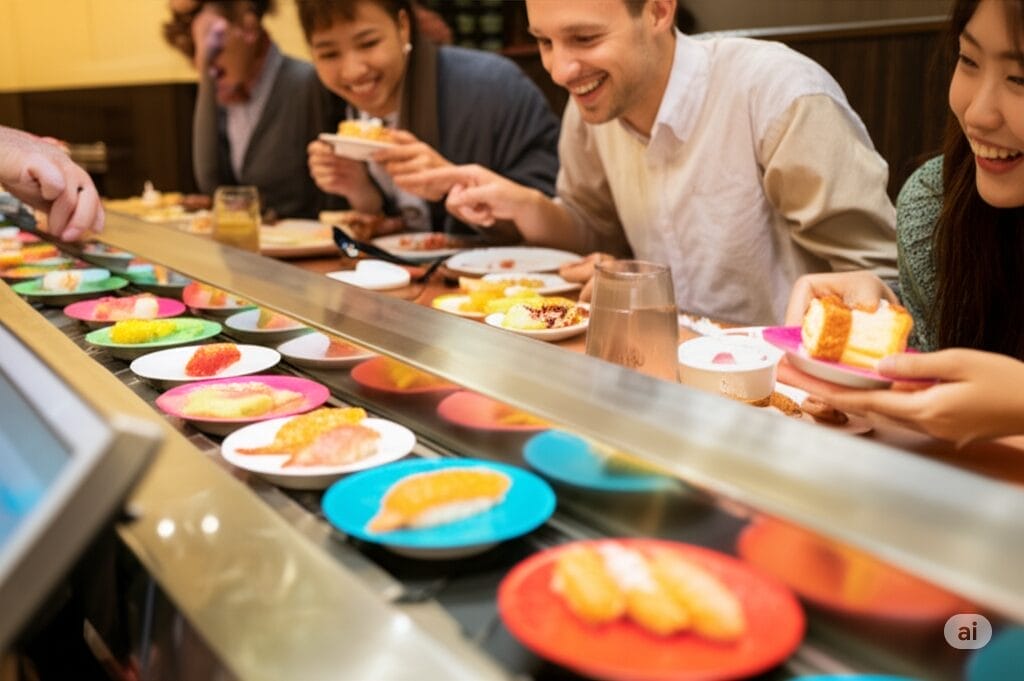日本の食文化の代表格である「寿司」。その中でも、手頃な価格で気軽に楽しめる「回転寿司」は、今や国内外問わず絶大な人気を誇ります。外国人の友人を案内する際、「このユニークなシステムをどう説明すればいいんだろう?」と悩んだ経験はありませんか?この記事を読めば、回転寿司の魅力から専門用語、実践的な英会話フレーズまで、自信を持って英語で説明できるようになります。より本格的に英会話を学びたい方は、英語教室で基礎から学ぶのも一つの良い方法です。
回転寿司は英語でなんて言う?基本の3表現
まず押さえておきたいのが、回転寿司の基本的な英語表現です。直訳からユニークな言い方まで、相手や状況に合わせて使い分けられるとスマートです。
1. Conveyor belt sushi – 最も一般的で分かりやすい表現
文字通り「ベルトコンベアの寿司」を意味する Conveyor belt sushi が、最も一般的で誰にでも通じやすい表現です。回転寿司を知らない人に初めて説明する際は、この表現を使うのが最も確実でしょう。
“Kaiten-sushi is a type of sushi restaurant where the plates with the sushi are placed on a rotating conveyor belt. So, we call it ‘conveyor belt sushi’.”
(回転寿司は、寿司の乗った皿が回転するベルトコンベアに乗せられている寿司レストランの一種です。だから私たちはそれを『コンベアベルト寿司』と呼びます。)
2. Sushi-go-round – 楽しさを伝えるユニークな表現
メリーゴーランド (merry-go-round) を彷彿とさせる Sushi-go-round という表現もよく使われます。こちらは、お寿司が回るエンターテイメント性や楽しさを伝えたいときにぴったりの、少し遊び心のある言い方です。
“Have you ever been to a ‘sushi-go-round’ restaurant? It’s really fun because you can just grab whatever you want as it passes by.”
(「寿司ゴーラウンド」のレストランに行ったことはありますか?目の前を通り過ぎるものを何でも取れるので、とても楽しいですよ。)
3. KAITEN SUSHI – 日本文化好きには通じる表現
ラーメンが “Ramen”、カラオケが “Karaoke” として世界で通じるように、日本のポップカルチャーに詳しい人や日本在住経験のある外国人には KAITEN SUSHI という日本語がそのまま通じることも少なくありません。相手の日本への理解度に応じて使ってみましょう。
“When you come to Japan, you should definitely try KAITEN SUSHI! It’s a must-do experience for tourists.”
(日本に来たら、絶対に回転寿司を試すべきだよ!観光客にとって必須の体験だからね。)
なぜ日本の回転寿司は世界で人気?魅力を英語で伝えよう!
「ただ寿司が回っているだけでしょ?」と思っている外国人は意外と多いかもしれません。回転寿司がなぜこれほどまでに愛されているのか、そのユニークな魅力を英語で具体的に伝えてみましょう。

回転レーンとタッチパネルは、回転寿司の楽しさの象徴です。
魅力①:驚きの安さとクオリティ (Amazing quality for a reasonable price)
回転寿司最大の魅力は、なんといってもそのコストパフォーマンスです。「寿司=高級品 (fancy dish)」というイメージを持つ外国人にとって、1皿100円程度から楽しめる手軽さは衝撃的です。安かろう悪かろうではなく、新鮮で美味しいネタが楽しめる点を強調しましょう。
You won’t believe it, but you can get a plate of two sushi pieces for about 100 yen.
(信じられないかもしれないけど、2貫で100円くらいなんだよ。)Even though it’s cheap, the quality is surprisingly high. It’s very fresh.
(安いけど、クオリティは驚くほど高いんだ。とても新鮮だよ。)The price is calculated by the number and color of the plates you’ve eaten. It’s a very simple and clear system.
(値段は食べたお皿の枚数と色で計算されるんだ。とてもシンプルで分かりやすいシステムだよ。)
魅力②:エンターテイメント性の高さ (A fun and entertaining experience)
次から次へと流れてくるお寿司を眺め、「次はどれにしようかな?」と選ぶプロセスは、食事でありながらエンターテイメントでもあります。タッチパネルでの注文や、注文品が「特急レーン」で素早く届く様子、食べたお皿を5枚入れると景品が当たるゲームなど、子供から大人まで楽しめる工夫が満載です。
It’s like a food theme park! You can pick any sushi you like from the conveyor belt.
(まるで食べ物のテーマパークみたいだよ!ベルトコンベアから好きな寿司を選べるんだ。)If you can’t find what you want, you can order directly using a touch screen at your seat.
(もし欲しいものが見つからなくても、席にあるタッチパネルで直接注文できるよ。)In some restaurants, your order arrives on a miniature bullet train! It’s called the ‘Shinkansen lane’.
(お店によっては、注文品がミニチュアの新幹線で届くんだ!『新幹線レーン』って呼ばれてるよ。)

寿司だけでなく、豊富なサイドメニューも回転寿司の大きな魅力です。
魅力③:メニューの多様性 (A wide variety of dishes)
「生魚 (raw fish) はちょっと苦手…」という外国人も心配ありません。最近の回転寿司は、炙り寿司 (seared sushi) や肉寿司、天ぷら、サラダ軍艦といった創作寿司から、ラーメン、うどん、フライドポテト、唐揚げ、さらには本格的なデザートまで、信じられないほど多彩なサイドメニューが揃っています。
Don’t worry if you’re not a big fan of raw fish. They have a huge variety of other options.
(生魚があまり好きじゃなくても心配いらないよ。他にもたくさんの選択肢があるから。)Not only sushi, but they also serve ramen, french fries, and even cake!
(お寿司だけじゃなくて、ラーメンやフライドポテト、ケーキまであるんだ!)I recommend trying ‘Aburi’ sushi, which is lightly seared on top. It’s very savory and delicious.
(表面を軽く炙った「炙り」寿司がおすすめだよ。とても香ばしくて美味しいんだ。)
【実践編】外国人を案内する英会話フレーズ集
ここからは、実際に外国人の友人を回転寿司に案内する際に使える、シチュエーション別の英会話フレーズをご紹介します。これさえ覚えれば、案内から会計までスムーズにエスコートできます。

楽しく会話しながら、日本の食文化を伝えてみましょう。
① 誘う・入店する
Billy: What should we eat for dinner?
(ビリー:夕食は何を食べようか?)
You: How about conveyor belt sushi? It’s a unique Japanese experience and very affordable.
(あなた:回転寿司はどう?日本ならではの体験だし、すごく手頃だよ。)
Billy: Sounds great! What’s it like?
(ビリー:いいね!どんな感じなの?)
You: You’ll see! You don’t usually need a reservation, so we can just walk in.
(あなた:行けばわかるよ!普通は予約は要らないから、そのまま入れるよ。)
② システムを説明する
Billy: Wow, so many plates are moving around! How does this work?
(ビリー:うわー、たくさんのお皿が回ってる!どういう仕組みなの?)
You: You can take any plate you want from the belt. Or, you can order specific items from this touch screen.
(あなた:ベルトから好きな皿を自由に取っていいんだ。もしくは、このタッチパネルで特定のネタを注文することもできるよ。)
You: This is green tea powder. You can make your own tea. The hot water tap is right here.
(あなた:これは粉末の緑茶。自分でお茶を淹れるんだ。お湯の蛇口はここにあるよ。)
You: You’ll find pickled ginger, called ‘gari’, in this container. It’s for cleansing your palate between different types of sushi.
(あなた:この容器に入っているのは「ガリ」っていう生姜の甘酢漬けだよ。違う種類の寿司を食べる合間の口直しにどうぞ。)
③ ネタを説明・おすすめする
Billy: What’s this one? It looks delicious.
(ビリー:これは何?美味しそうだね。)
You: That’s ‘salmon roe’, called Ikura. The small eggs pop in your mouth. You should try it!
(あなた:それは「イクラ」。サーモンの卵だよ。口の中でプチプチ弾けるんだ。試してみて!)
Billy: I’m not sure about raw fish…
(ビリー:生魚はどうかなあ…)
You: Then how about this? It’s seared shrimp with mayonnaise. Or we could order some fried chicken or noodles.
(あなた:じゃあこれはどう?炙りエビマヨだよ。それか、唐揚げか麺類を頼もうか。)
You: If you don’t like wasabi, you can ask for ‘sabi-nuki’, which means ‘without wasabi’.
(あなた:もしワサビが苦手なら、「サビ抜き」って頼めるよ。「ワサビなし」って意味なんだ。)
④ 会計する
Billy: I’m so full! How do we pay?
(ビリー:お腹いっぱい!どうやって支払うの?)
You: We just need to call a staff member by pressing this button. They will come and count our plates.
(あなた:このボタンを押して店員さんを呼ぶだけだよ。そしたらお皿を数えに来てくれるんだ。)
Staff: I will count your plates. Thank you for waiting. Your total is 2,500 yen.
(店員:お皿を数えますね。お待たせいたしました。合計で2,500円です。)
You: We take this bill to the cashier at the entrance.
(あなた:この伝票を持って、入り口のレジに行くんだよ。)
回転寿司で役立つ英単語・ボキャブラリー一覧
より詳しく、より正確に説明するために、回転寿司に関連する便利な単語や表現を覚えておきましょう。
基本のネタ・食材
- Tuna: マグロ
- Lean tuna (Akami): 赤身
- Medium-fatty tuna (Chutoro): 中トロ
- Fatty tuna (Otoro): 大トロ
- Salmon: サーモン
- Shrimp (Ebi): エビ
- Sweet shrimp (Amaebi): 甘エビ
- Squid (Ika): イカ
- Octopus (Tako): タコ
- Eel (Unagi): うなぎ
- Sea urchin (Uni): ウニ
- Salmon roe (Ikura): いくら
- Egg omelet (Tamago): 玉子焼き
- Raw fish: 生魚
- Seared / Torched: 炙り
- Dried seaweed (Nori): 海苔
注文・設備関連
- Sushi chef (Itamae): 板前さん
- Touch screen: タッチパネル
- Express lane / Shinkansen lane: 特急レーン
- Pickled ginger (Gari): ガリ
- Soy sauce (Shoyu): 醤油
- Wasabi: わさび
- Without wasabi (Sabi-nuki): サビ抜き
- Limited edition: 期間限定
- Today’s special: 本日のおすすめ
- In season: 旬のネタ
- Take-out / To-go: 持ち帰り
- Bill / Check: お会計・伝票
【応用編】もっと伝わる!回転寿司の歴史と最新トレンド
雑学として回転寿司の歴史や最新事情を知っておくと、会話がさらに盛り上がります。外国人の知的好奇心をくすぐる豆知識を披露してみましょう。
回転寿司はいつ、どこで始まった? (The Origin of Kaiten Sushi)
回転寿司が誕生したのは、1958年の大阪です。元禄産業の創業者である白石義明氏が、ビール工場の瓶詰め用ベルトコンベアからヒントを得て「コンベヤ旋廻食事台」を開発したのが始まりでした。高級だった寿司を、より多くの人に手軽に楽しんでもらいたいという想いが、この画期的なシステムを生んだのです。
“Actually, conveyor belt sushi was invented in Osaka in 1958. The inventor got the idea from a beer bottling conveyor belt at a factory. His goal was to make expensive sushi more accessible to everyone.”
(実は、回転寿司は1958年に大阪で発明されたんだ。発明者は、工場のビール瓶詰め用ベルトコンベアからアイデアを得たんだよ。彼の目標は、高価な寿司を誰もがもっと手軽に食べられるようにすることだったんだ。)
ハイテク化が進む最新の回転寿司 (High-tech Revolutions)
現代の回転寿司は、単に皿が回るだけではありません。IT技術を駆使して、驚くべき進化を遂げています。多くの店舗では、タッチパネルでの注文が当たり前。さらに、皿の裏にICタグを取り付け、レーンを流れる寿司の鮮度を管理したり、売上データをリアルタイムで分析して廃棄ロスを減らしたりするシステムも導入されています。一部の店舗では、客席への案内や会計をロボットが行うなど、省人化・効率化も進んでいます。
“Modern kaiten sushi restaurants are incredibly high-tech. They use IC chips on the plates to track freshness and analyze sales data to reduce food waste. Some even have robots to guide you to your seat!”
(現代の回転寿司店は信じられないほどハイテクだよ。皿にICチップを付けて鮮度を管理したり、売上データを分析して食品ロスを削減したりしているんだ。席まで案内してくれるロボットがいる店さえあるよ!)
まとめ:自信を持って日本の回転寿司文化を英語で紹介しよう!
「回転寿司」を英語で説明するための表現やフレーズ、そして背景にある文化や最新情報をご紹介しました。単なる食事ではなく、日本の「食」「技術」「おもてなし」が詰まったユニークなエンターテイメントであることがお分かりいただけたかと思います。
今回学んだフレーズを使えば、きっと外国人の友人も回転寿司の楽しさと奥深さを理解し、最高の思い出を作ってくれるはずです。ぜひ自信を持って、日本の誇るべき食文化を英語で伝えてみてください。



